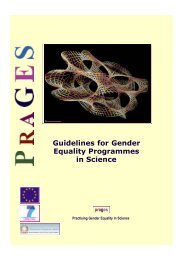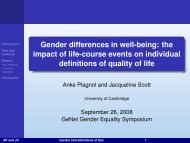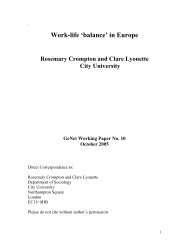Job insecurity, gender and work orientation: an exploratory ... - GeNet
Job insecurity, gender and work orientation: an exploratory ... - GeNet
Job insecurity, gender and work orientation: an exploratory ... - GeNet
Create successful ePaper yourself
Turn your PDF publications into a flip-book with our unique Google optimized e-Paper software.
‘careerist’ did not seem a priority for <strong>an</strong>y member of this group. Other women, however,<br />
though not rejecting the idea of labour market participation altogether, seemed to have<br />
prioritised their domestic lives. Only two women were placed in the Traditionalists<br />
category each showing a strong attachment to homemaking. Finally, two single women<br />
showed a very strong interest in career adv<strong>an</strong>cement <strong><strong>an</strong>d</strong> were coded as ‘Ambitious’.<br />
However, neither could be described using Hakim’s notion of ‘<strong>work</strong>-centred’ as they had<br />
not ruled out the idea of starting families at a later stage. Each foresaw a time when they<br />
would expect to ‘compromise’ their employment aspirations to some degree.<br />
Table 4 shows that there are noticeable differences between each group in terms<br />
of their family form, attitudes to the domestic division of labour 1 <strong><strong>an</strong>d</strong> occupational status 2 .<br />
The first, descriptive, round of coding focused on the priority particip<strong>an</strong>ts placed on<br />
either <strong>work</strong> or family. The ‘Bal<strong>an</strong>cers’ have a variety of family forms, occupations <strong><strong>an</strong>d</strong><br />
<strong>gender</strong> role attitudes, the ‘Traditionalists’ were married with children, <strong>work</strong>ed part-time<br />
<strong><strong>an</strong>d</strong> had a strong identification with traditional <strong>gender</strong> roles, <strong><strong>an</strong>d</strong> the ‘Ambitious’ were<br />
single, full-time professionals with a weak attachment to traditional <strong>gender</strong> roles.<br />
According to Hakim’s thesis this variation c<strong>an</strong> be ‘explained’ because these women were,<br />
to a large extent, in a position to ‘choose’ from the wide variety of occupations, family<br />
forms <strong><strong>an</strong>d</strong> values available to individuals in modern societies. There is nothing wrong<br />
with highlighting the import<strong>an</strong>ce of choice per se, as the ability to choose is a key<br />
characteristic of hum<strong>an</strong> agency (Collier, 1994; Mouzelis, 1995). Nevertheless, it became<br />
clear during the second, interpretive, round of coding, which focused on the conditions<br />
<strong><strong>an</strong>d</strong> consequences of individual life trajectories, that labour market opportunity, support,<br />
<strong><strong>an</strong>d</strong> ideologies of care all interacted in a complex way to make the experience of job<br />
<strong>insecurity</strong> very different for each group.<br />
1 Attitudes to the division of labour were assessed using the following questions (respond on a 5 point scale<br />
r<strong>an</strong>ging from ‘strongly agree’ to ‘strongly disagree’:<br />
i) A m<strong>an</strong>’s job is to earn the money; a wom<strong>an</strong>’s job is to look after the home <strong><strong>an</strong>d</strong> family.<br />
ii) Men c<strong>an</strong> have just as warm <strong><strong>an</strong>d</strong> secure a relationship with pre-school children as women c<strong>an</strong>.<br />
iii) A pre-school child is likely to suffer if his or her mother <strong>work</strong>s.<br />
2 Occupational groups were measured using Soc Major Group. Although, again, there is some debate as to<br />
the ‘best’ way of measuring occupational ‘status’ (Blackburn <strong><strong>an</strong>d</strong> Pr<strong><strong>an</strong>d</strong>y, 1997), the SOC classification<br />
was chosen as it is the classification favoured in the collection of census data.<br />
8






